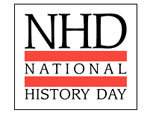BROWSE BY CATEGORY
- Archives and Libraries
- Blogs and Networking
- Bookmark This
- Digital Tools
- Examples of Teaching
- Exhibits
- Film Reviews
- History and Headlines
- Historic Sites and Museums
- Historical Thinking
- Holidays and Heritage
- Issues and Research
- Lesson Plans
- Material and Visual Culture
- Multimedia
- Organizations and Agencies
- Primary Sources
- Professional Development
- Publications
- Student Activities
- Teaching Materials
- Websites
Amy Trenkle on National History Day—It's More than Just a Day…and It's More than Just History

My students have been participating in National History Day since my first year teaching in the public schools—more than a decade ago. Since that first year, I have grown tremendously as a teacher and as a teacher who is guiding students through the National History Day process. There's a lot I could write about National History Day. I truly think it's one of the best programs for asking students to research and then synthesize their research through a project. It allows for choice, higher-order thinking skills, and diversity in the way the project is presented.
It’s that project presentation format I want to focus on. At first, and for quite a number of years, my students participated in the exhibit category because it was my strength as a teacher, but for the last three years or so, the number of students participating in the website and documentary categories has really grown. I have continued to learn and stretch my boundaries as a teacher as well.
For those of you new to National History Day I highly suggest checking their site out online at nhd.org. In a nutshell, however, here is the program: Students choose their own topic that fits within the annual theme (this year’s theme is "Debate and Diplomacy: Successes, Failures, and Consequences"), they choose to work individually or in groups of up to five students (with the exception of the research paper), and they choose one of five categories to present their project in: research paper, documentary, performance, exhibit, or website.
The website and documentary categories are particularly wonderful for integrating social studies content and using technology to display the students’ hard work and knowledge. Here are some highlights and sticking points that I’ve found while having students work with the website and documentary categories.
Pros of Website:
- Students can pull a myriad of images, sounds, videos, and other primary sources directly from the Internet and put them on their website. This encourages students to incorporate 21st-century skills, specifically technology skills, while asking them to analyze and evaluate sources they have chosen, placing them in historical context. As with any of the venues for NHD, this also calls on historical thinking skills and meeting research standards for English Language Arts.
- It's free—as long as students have access to a computer and the Internet they can complete a website!
- It can be taken with students easily from home, to school, to aftercare.
- The website category is now streamlined through nhd.weebly.com. The beauty of this is that students who are just beginning may choose to use the drag-and-drop features of the website. Those who are more advanced may write their own HTML code to alter the site and create their own unique website.
Cons of Website:
- It's easy for students to ONLY use web sources for their project. Getting students to scan sources or construct their own videos and edit them can easily be overlooked if the teacher and parents are not vigilant.
- Students spend a lot of time with nuances of design like font and font size, sometimes to the detriment of the HISTORY of the project.
Pros of Documentary:
- Again, this type of project encourages students to incorporate 21st-century skills, specifically technology skills, while asking them to analyze and evaluate the sources they have chosen, placing them in historical context.
- Documentaries are very impressive when they are finished and done well.
- It can be very easy to map out the story, write a script, and then find the primary sources to "tell" that story.
Cons of Documentary:
- Students need to come to the project with at least a basic working knowledge of iMovie or Moviemaker.
- Students have to be prepared to spend a lot of time on the making and editing of the movie—it doesn’t have as much to do with the history of the topic, but rather presentation. This also becomes a tempting choice for the student who would rather not do as much historical work.
I think it's important to remember that it's about balance. As a teacher, I have seen students spend an inordinate amount of time on the creation of their website or documentary only to neglect the history. I've also seen students do a dynamic job of researching their topic, only to not present it in the best format because they don't allow enough time or have the background knowledge to create their presentation in the format they chose. It's very important to have a pulse of the students' strengths and time constraints when choosing the format for the project. One of the neat things is that NHD allows students to experiment with the presentation format and is a great way to highlight the integration of social studies and technology!
With planning and communication you and your students will have a great time learning history through National History Day!
For more information
Take a few minutes in our Tech for Teachers section—learn about NHD's website-making tool of choice, Weebly, and documentary-creation tools like Digital Storyteller.
Check out a second-place-winning website, our blog entry on NHD 2010, or read an article on NHD's history.
And what exactly are 21st-century skills? Six experts give their views in our Roundtable.
